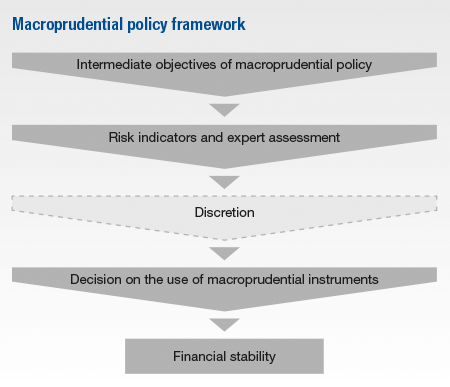Macroprudential politics
Macroprudential policy means, in addition to macroprudential supervision and analysis, specific measures aimed at preventing systemic risks and geared to the ultimate objective of safeguarding the stability of the financial system as a whole. Macroprudential policy therefore supports microprudential supervision, i.e. supervision of individual institutions as well as fiscal and monetary policies aimed at achieving sustainable economic growth.
The FIN-FSA Board decides on macroprudential policy. Decisions on measures are based on thorough expert assessments with the primary purpose of identifying potential risks to financial stability as early as possible. Such expert assessments are guided by quantitative risk indicators, which have been shown, based on research studies and empirical evidence, to signal the build-up of systemic risks and describe the state of the financial sector. In Finland, expert assessment is undertaken in broad-based cooperation between the authorities, involving, in addition to the FIN-FSA, the Bank of Finland and the Ministry of Finance.
In practice, macroprudential risks to the financial sector are assessed via intermediate objectives of macroprudential policy. These objectives constitute an analytical basis for the assessment of systemic risks and guide the selection of measures for risk prevention and the monitoring of their effectiveness. In order to have common European practices in place, the European Systemic Risk Board (ESRB) has issued a recommendation on intermediate objectives and instruments of macroprudential policy (ESRB/2013/1, in Finnish). According to the recommendation, the intermediate objectives of national macroprudential authorities should include the following:
- to mitigate and prevent excessive credit growth and leverage
- to mitigate and prevent excessive maturity mismatch and market illiquidity
- to limit direct and indirect exposure concentrations
- to limit the systemic impact of misaligned incentives with a view to reducing moral hazard
- to strengthen the resilience of financial infrastructures.
Each intermediate objective of macroprudential policy can be managed using one or more macroprudential instruments. Macroprudential instruments are based on EU legislation (EU Capital Requirements Regulation and Capital Requirements Directive), which may be supplemented in national legislation by separately assigned powers to macroprudential authorities. More information on measures included in EU and national legislation is provided in the section Macroprudential instruments.

Source: ESRB – Flagship Report on Macro-prudential Policy in the Banking Sector.